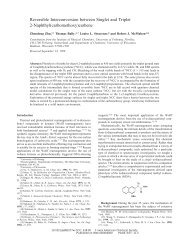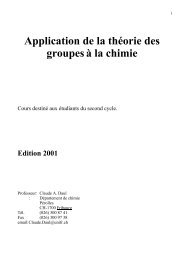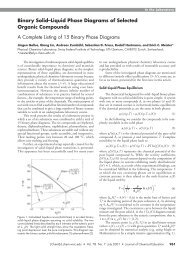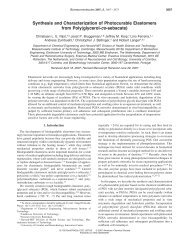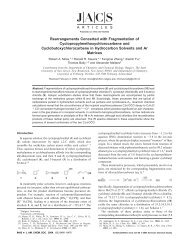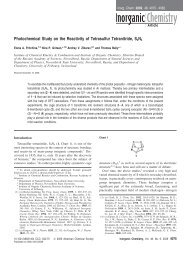Ultrafast Spectroscopic and Matrix Isolation Studies of p-Biphenylyl ...
Ultrafast Spectroscopic and Matrix Isolation Studies of p-Biphenylyl ...
Ultrafast Spectroscopic and Matrix Isolation Studies of p-Biphenylyl ...
Create successful ePaper yourself
Turn your PDF publications into a flip-book with our unique Google optimized e-Paper software.
<strong>Ultrafast</strong> Spectroscopy <strong>of</strong> Arylnitrenium Cations ARTICLES<br />
Figure 1. Transient spectra produced by ultrafast photolysis <strong>of</strong> p-biphenylyl<br />
azide 4 in acetonitrile-water (50% vs 50%) mixture. The spectra were<br />
generated by ultrafast LFP (270 nm) with a time window <strong>of</strong> 15-2500 ps.<br />
Figure 2. (a) UV-vis spectrum <strong>of</strong> p-biphenylyl azide 4 in an Ar matrix;<br />
(b) after photolysis at 254 nm; (c) after photolysis at 254 nm in the presence<br />
<strong>of</strong> 30% HCl in Ar; (d) after bleaching at λ > 590 nm.<br />
Scheme 5<br />
Calculations were performed to describe the nature <strong>of</strong> the<br />
electronic excitations responsible for the observed absorption.<br />
The geometry <strong>of</strong> the closed-shell singlet ground state <strong>of</strong><br />
p-biphenylylnitrenium cation 33,34 was optimized by B3LYP/6-<br />
31G(d) (Supporting Information, Figure S3). The singlet-triplet<br />
gap <strong>of</strong> this ion was not calculated in this study, but analogous<br />
values have been reported by Cramer <strong>and</strong> co-workers. 33,34 The<br />
two phenyl moieties were found to be twisted by 19.5°, in good<br />
agreement with the dihedral angle 17.6° reported by Zhu et al. 25<br />
The presence <strong>of</strong> the NH + substituent changes the electronic<br />
structure <strong>of</strong> the molecule. In particular, the weight <strong>of</strong> the VB<br />
resonance structures which maintain a double bond between the<br />
two phenyl groups increases sensibly (Scheme 5 <strong>and</strong> Supporting<br />
Information, Figure S3) thus favoring planarization <strong>of</strong> the<br />
biphenylylnitrenium cation. However, the increased double-bond<br />
character between the two phenyl rings also leads to a shortening<br />
<strong>of</strong> the inter-ring distance by 0.045 Å, <strong>and</strong> the resulting additional<br />
Table 1. Excited States <strong>and</strong> Oscillator Strength for<br />
p-<strong>Biphenylyl</strong>nitrenium Cation 6 Calculated by the CASSCF <strong>and</strong><br />
CASPT2 Methods<br />
CASSCF/eVa CASPT2/eVb CASPT2/nm<br />
oscillator<br />
strength excitations/% c<br />
(0.00) (0.00) 74% ground config<br />
2.42 2.28 545 1.2 × 10-2 66% (H-1 f L)<br />
3.60 2.52 493 5.4 × 10-1 53% (H f L)<br />
4.13 3.23 384 4.0 × 10-2 38% (H-2 f L)<br />
+ 25% (H-2 f L +<br />
H f L)<br />
4.97 3.75 330 2.1 × 10-1 highly mixed<br />
5.06 4.16 298 1.2 × 10-1 highly mixed<br />
5.41 3.93 315 6.6 × 10-2 highly mixed<br />
a Active space comprises 10 electrons in 10 π orbitals, ground state<br />
energy: -514.557109 hartree. b Ground state energy: -516.086437 hartree.<br />
c Main excitations in the CASSCF wave function, where H ) HOMO <strong>and</strong><br />
L ) LUMO.<br />
steric hindrance <strong>of</strong> the ortho hydrogen atoms means that<br />
planarity is not reached in p-biphenylylnitrenium cation, in spite<br />
<strong>of</strong> the stronger inter-ring double-bond character.<br />
At the optimized geometry, the excited states were calculated<br />
by the CASPT2 method, based on a reference CASSCF wave<br />
function with an active space comprising 10 electrons in 10<br />
orbitals. The orbitals which are involved mainly in the excitations<br />
that lead to the observed b<strong>and</strong>s <strong>of</strong> 6 are listed in Table 1<br />
<strong>and</strong> shown in Figure S4 <strong>of</strong> the Supporting Information. The<br />
first excitation, predicted at 545 nm, corresponds mainly to<br />
HOMO f LUMO electron promotion but, owing to poor<br />
overlap between the ground state <strong>and</strong> the excited-state wave<br />
function, the transition moment is small. The following excitation,<br />
predicted at 493 nm, is composed <strong>of</strong> a 53% HOMO f<br />
LUMO excitation. The intensity <strong>of</strong> this b<strong>and</strong> is higher because<br />
<strong>of</strong> greater overlap <strong>of</strong> the MOs between which the electronic<br />
promotion occurs. Higher excitations are predicted with a lower<br />
intensity, <strong>and</strong> all <strong>of</strong> them are <strong>of</strong> mixed character involving<br />
mainly excitations to the π-LUMO. As a result <strong>of</strong> the essentially<br />
nonbonding character <strong>of</strong> the LUMO, promoting electrons into<br />
higher virtual orbitals requires more energy than promoting them<br />
from lower occupied MOs to the LUMO.<br />
The quantitative accord <strong>of</strong> the CASPT2 calculations (red bars<br />
in Figure 2) with experiment is satisfactory, <strong>and</strong> the main strong<br />
b<strong>and</strong>, mainly due to HOMO f LUMO excitation, is well<br />
reproduced.<br />
The corresponding IR spectra (Figure 3), recorded under the<br />
same conditions <strong>of</strong> photolysis as the UV-vis spectra in Figure<br />
2 (red trace), show some peaks that increase after the first<br />
irradiation at 254 nm (spectrum b) <strong>and</strong> decrease on bleaching<br />
the photoproduct at λ > 590 nm (spectrum c). Dashed lines<br />
associate these b<strong>and</strong>s with peaks in the calculated spectrum a<br />
<strong>of</strong> the p-biphenylylnitrenium cation. The position <strong>and</strong> relative<br />
intensity <strong>of</strong> most <strong>of</strong> the b<strong>and</strong>s are reproduced reasonably well<br />
by the B3LYP calculations (spectrum a in Figure 3), but accord<br />
with experiment is somewhat lacking because some important<br />
calculated b<strong>and</strong>s are missing in the experimental spectrum.<br />
A possible origin <strong>of</strong> the poor matching may be the significant<br />
increase <strong>of</strong> the polarity <strong>of</strong> the medium containing the cation,<br />
caused by the presence <strong>of</strong> HCl in the matrix. Hence, interaction<br />
with the solvent, not considered in the calculations, could acquire<br />
significant importance in correctly describing the force field <strong>of</strong><br />
the molecule. In particular, the resulting IR spectrum could have<br />
J. AM. CHEM. SOC. 9 VOL. 129, NO. 26, 2007 8383




